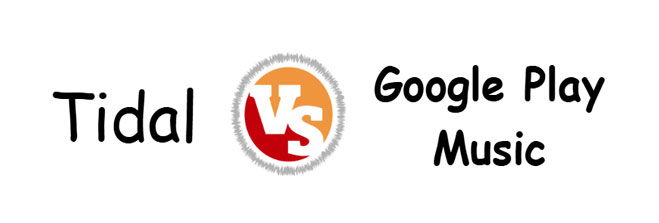In the world of music streaming, plenty of apps battle to offer the best to users. Each service comes with utilities that distinguish it from the rest.
Looking at Tidal vs Google Play Music, it is clear that they serve the same market but differs in features, pricing, app features, and software. But who's the king?
When it comes to Google Play Music, the online music streaming service kicked off in 2011 and has been battling for the market's attention in the past few years. It has developed a significant music catalog of over 500 million and offers free music upload for up to 50,000 songs for free.
Tidal, on the other hand, began in 2015 as the only music streaming service that offers lossless quality audio. It has a library of over 60 million tracks and 250000 HD videos. It aims at providing the best audio-quality streaming service in the market.

Google Play Music vs Tidal: Who Provides Better Music Streaming Service
Google Play Music comes with robust features with its massive catalog being top on the list. It has over 500 million songs to choose from. From old school to modern music, the tool has no shortage of music or artists that aren't known all over the world. Nearly every artist or song you'll search on Google play music you'll find.
Better yet, Google Play Music offers online storage and listening for up to 50,000 songs from your library at no cost. And when you choose to go premium, you can demand to stream any song in Google Play Music Catalogue as well as on the YouTube premium.
What's more, if you want to stream music and videos on your TV from the app, Google Play Music is chrome cast enabled to execute that desire. Even more, regardless of whether you're on free or the paid version, you can discover new music with a custom radio station, downloadable for offline listening.
On the other side, Tidal has a comparatively smaller catalog of 60 million songs of Hi-Res and lossless audio quality, as well as over 250,000 HD Music videos you can try. Besides, Tidal presents thousands of CD and quality radio stations where you can discover new music to add to your library. But that isn't all. The service stretches beyond to unlock exclusive access to music video before their official release.
It’s also worth noting that there is a well-designed tool for Tidal, called AudFree Tidal Music Converter, which is specialized in downloading Tidal music, playlists and albums offline and convert them to common audio formats, like FLAC, WAV, AAC, MP3, M4A and M4B so that you can listen to Tidal music on any devices without using Tidal app.
However, it is difficult to find the music of your choice on Tidal. Suppose you misspell a title or the artist's name, it gets challenging to find the song you are looking for. This is unlike Google Play Music, which auto-correct and executes your search.
When it comes to features of Google Play Music vs Tidal, and their usefulness- to a wide range of people, Google Play Music appears to be the better among the two.
Audio Quality Google Play Music vs. Tidal
In audio quality, Tidal is non-compromising. It offers pure sound, with a lossless audio experience. In the world of music streaming, no competitor comes closer to Tidal in terms of audio quality. It is their most prominent feature.
On the other hand, the highest audio quality on Google Play Music is 320Kbps. Even if you upload lossless audio, it will get degraded to 320 kbps MP3 after some time.
On audio quality Google play music vs Tidal, Tidal is unbeatable.
Google Play Music vs Tidal Software
Google Play Music has no software client, but it is an open source on GitHub which gives the user the say in its entire feature. The software is resource-efficient, versatile, and nearly all operations are executed on the Chrome browser.
However, a browser for music streaming isn`t pleasing to everyone—it is annoying when the music stop playing when you accidentally close the tab.
On the other side, Tidal desktop app is mightily refined and well-organized on Windows, macOS, iOS, and Android platforms. However, it has some flaws that make it fail to play precise songs.
Although Tidal is well-refined, Google Play Music software wins because it is more customizable and easy to use.
App Design
Google Play Music has the Android design whose interface is familiar to many users. This is a significant advantage as people find it easier to use. What`s more, the default color of Google Play Music is light and clean but not customizable. Even more, the app automatically generates playlists instantly after you launch it. This makes it easy for you to find the music you want in no time.
On the other hand, Tidal opens on a dark-themed background of black and grey, which contrasts flawlessly together. Tidal's user interface can be a little intimidating for a new user. It is entirely the opposite of Google Play Music.
Another problem with Tidal is that it has limited playlists, and getting one of your choices can be challenging. The software has a mind of its own.
However, Tidal beats Google Play Music on design. Google Play Music interface is a bit clunky.
Price
There is quite a different in terms of pricing on Tidal vs Google Play Music. Google Play Music has both paid and free version with 30 days trial for the premium plans. The standard plan costs nothing but presents free music streaming with no ads, and up to 50000 online music storage.
For $9.99 a month, you get all access—watching music videos and albums, offline play, and unlimited skips. The family plan goes for $14.99 for 6 family members with all access.
Tidal lacks free music streaming plan. However, it has a 30-day trial period that precedes several pricing tiers. The standard plan charges $9.99 a month. The plan gives access to audios of, flawlessly curated editorial, and HD music videos. For $19-99 per month, Tidal present to you HiFi streaming in addition to what Standard Plan offers.
Family premium goes for $ 14 a month for up to 6 family members and offers Standard sound quality, HD music videos, and hand-picked mixes depending on your location. Besides, Tidal has Family HiFi plan, which goes for $ 29.99 and offers HiFi music in addition to what Family Premium provides. What's more, the Tidal service offers Student Premium tier, which goes for $4.99 a month and Student HiFi plan that goes to $9.99.
When it comes to price, Google Play Music beat Tidal as they have a free plan in addition to the premium options.
Availability
Google Play Music is available in 63 countries, while Tidal is only available in 53 countries. Google Play Music wins on availability.
The Bottom Line
Based on the results from comparing Tidal vs Google Play Music, Google Play Music comes on top. It has got massive popularity, significant library size and available in many countries. Though Tidal is powerful, features like a free plan on Google Play Music makes it more preferable.

Miley Swift
Staff Editor











